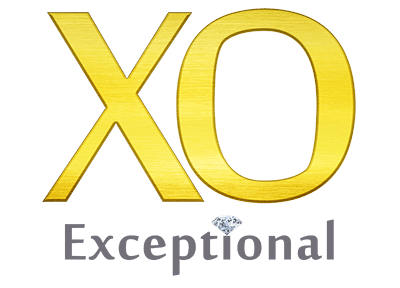Diamond Information & Buying Guide
Information in this article, unlike most others which solely describe quality characteristics of diamonds commonly known as the 4Cs, it also guides you through selecting and buying the best diamond for your money.
Brief History
Early diamond trading dates back to the 4th century BC in India when diamonds slowly found their way to Europe’s high society through traveling merchants.
In the early 1700s, Brazil started becoming an important source due to diminishing supplies from India, and it eventually became the major supplier of diamonds to the world for over 150 years.
In the year 1862, the largest diamond mine was discovered in Kimberley, South Africa.
Twenty two years later, Cecil Rhodes established De Beers and within a few years it became the world’s largest rough diamond supplier, capturing about 90% of global market’s share.
Since then, De Beer’s market share has decreased as new large mines have been discovered in Canada, Russia and African countries like Zaire and Botswana.
Technical Specs
Diamonds are formed under high pressure and temperatures about one hundred miles deep inside the earth. Diamond is nearly 100 percent (99.95%) carbon, making it the only precious gemstone made up of a single element with an isometric crystal structure. Diamond is fifty eight times harder than any other material in nature, its refractive index is 2.42, specific gravity is 3.52 and MOHS hardness is 10.
Quality & Value
The factors used in grading a diamond’s quality are its: Cut, Color, Clarity and Carat Weight, commonly known as the 4Cs. This system developed by Gemological Institute of America (GIA) has become the standard grading system used by the professionals throughout the industry.
Rarity of one or more of these characteristics, determine the value of a diamond. For example colorless diamonds are sparse and more valuable than majority which have a yellow or brown tint. The same interrelationship between scarcity and value exists for clarity, cut, and carat weight.
No two diamonds are worth the same as each has a unique combination of size, color, cut / proportions and internal characteristics known as clarity.
Shape
Primary shapes which rough diamonds are cut into for use as center stones in fine jewelry are shown below. There are plenty of other shapes that smaller roughs are cut into like: kite, bullet, trilliant, triangle, baguette, half moon, shield and trapezoid. What determines the final shape of a diamond is the shape of its rough as maximizing the final size of the polished diamond is one of primary objectives considered before cutting.
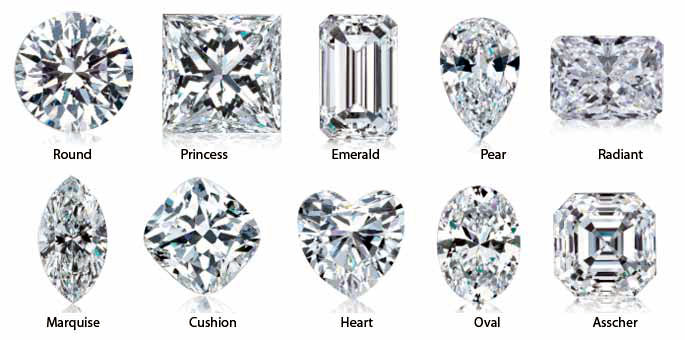
Shape FAQs
What does ‘fancy shape diamonds’ mean? All shapes except Round are called Fancy. Primary reason for this general categorization is because pricing structure for round diamonds at manufacturing and wholesale levels is higher than for fancy shapes.
What is the best diamond shape to buy? There is no such a thing as best shape for a diamond. Women choose their diamond’s shape based on their personal taste and preference. The more proper question is rather how to buy the best diamond at the lowest price? Or simply said, getting the best value for your money.
Does a diamond’s shape affect its price / value? Yes. Round diamonds are more expensive than fancy shapes in any given quality and size. And as with all products and commodities, supply and demand plays an important role in determining price of a diamond at both wholesale and retail levels.
Which diamond shape has the best resale value? Rounds because of their overwhelming popularity over other shapes but when shopping for a diamond, your focus should be on ‘value’ which means buying a great diamond at the right price in the shape that your fiance would love to have and wear. Because in most cases diamond is set in a sentimental piece of jewelry like a wedding ring that signifies your love and commitment for a lifetime. And even if you decide to sell or upgrade it in the future, you will get paid or reimbursed for its full value or very close.
Cut
A diamond’s cut which refers to its proportions, polish and symmetry, determines how it reflects light. Diamonds with Excellent, Ideal or Very Good cut grades make best use of light, resulting in maximum brilliancy and sparkle. Diagrams below demonstrate how a diamond’s cut affects the light entering it gets reflected.
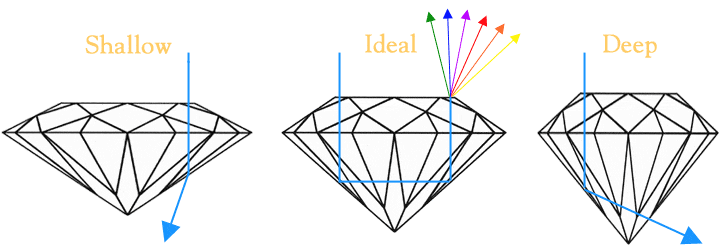
Below diagram shows proportions for Ideal to Very Fine cut grade set by Gemological Institute of America (GIA). Note that none of values are absolute, but rather a range.
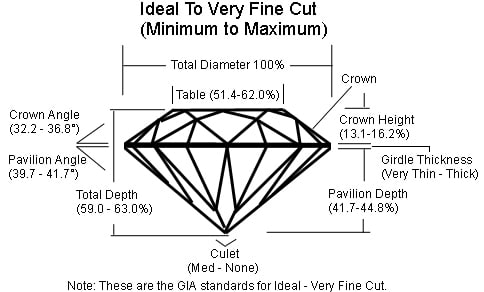
Cut FAQs
Are ‘Cut’ and ‘Shape’ the same? No, ‘Cut’ refers to diamond’s proportions, symmetry and polish. ‘Shape’ refers to the diamond’s overall shape: round, oval, cushion cut, pear shape, emerald cut, princess cut ….
What’s the best ‘Cut’ for a diamond? Above diagram shows range of proportions for ‘Ideal’ to ‘Very Fine’ cut grade diamonds. Even though brilliancy of a diamond is determined by its cut grade, keep in mind it is only one of the 4Cs used to determine its value.
Do all GIA certified diamonds come with a ‘Cut’ grade? GIA assigns ‘Cut’ (proportions, symmetry and polish) grade to round diamonds but polish and symmetry grades only to fancy shapes (ovals, pears, emerald, radiant cuts…) as there is no standard dimensions or length to width ratio for fancy shapes. Diameter of a round diamond is one of its cut grade indicators. For example, diameter of an ideal cut 1.00 carat round diamond is 6.5 millimeters.
Color
Colorless / White Diamonds: White diamonds’ color ranges from ‘D’ (colorless, most rare & valuable) to ‘Z’, lowest color grade with tints of yellow or brown.

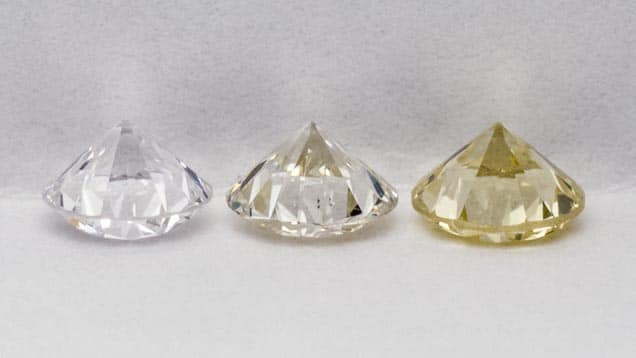
Slightest change in color shade of a diamond, affects its price and value noticeably. Difference between adjacent color grades (like ‘H’ and ‘I’) is so subtle, that it is almost impossible to differentiate under ordinary lighting. Very slight tints of yellow or brown start becoming noticeable to the naked eye at ‘I’ or ‘J’ colors in rounds and ‘H’ color in fancy shape diamonds (oval, pear shape, cushion, princess cut..). This is because light entering fancy shape diamonds does not get reflected evenly due to having asymmetrical shape, pointed corners or tips. So any tint of color appears concentrated and more visible in the corners / tips.
Color FAQs
What color diamond should I buy? You should buy a diamond that faces up white, which means if not colorless, it is near colorless and fits your budget. ‘D’, ‘E’, ‘F’ and sometimes even ‘G’ color diamonds look pure white / colorless, and almost impossible to differentiate. ‘G’ and ‘H’ colors are the most sought after colors by consumers because they cost less than higher, more expensive color grades yet have a very white appearance.
Do diamonds with identical color grade look the same? Most likely not as one or more of the following affect the color appearance. A: Diamond’s proportions, polish and symmetry B: Presence of fluorescence and its color tint (yellow, brown, blue) C: Technique used for grading color. Gemologists grade a diamond’s color by comparing it to color of master stones in the laboratory, and since difference between adjacent color grades (like ‘D’ and ‘E’) are so subtle, possibility of human error exists. This is proven true as some diamonds re-submitted to GIA for color check, come back with a different grade.
What is fluorescence? When exposed to ultraviolet radiation, some diamonds emit a visible light called fluorescence. Fluorescence comes in different intensities (faint, slight, medium, strong) and shades of white, yellow and blue as the most common.
Is fluorescence a desirable characteristic for diamonds? Generally no, fluorescence affects diamond’s brilliancy negatively making it look cloudy except under very limited circumstances. For example fluorescence in faint – medium blue intensity is desirable for ‘H’ and lower color diamonds as it hides yellow and brown tints, making diamond appear whiter without a visible impact on its brilliancy and sparkle.
Fancy Color Diamonds: Opposite to white / colorless diamonds, value of fancy color diamonds increases with their color intensity. Green, red, orange and purple are the rarest of fancy colors followed by pink, blue and yellow.
Brown diamonds were mainly used for industrial purposes until Australians found the largest brown diamond mines in 1980s and started marketing them under fancy names: ‘Cognac’ and ‘Champagne’. Today, brown diamonds are found in many lower priced jewelry due to their abundance and low cost.
Clarity
Clarity refers to inclusions: tiny mineral crystals trapped inside the diamond during its formation, and blemishes: scratches and nicks on diamond’s surface. ‘Flawless’ is the highest clarity grade for a diamond. As inclusions & blemishes increase, clarity grade and value of the diamond decrease.

Similar to fingerprint, each diamond has a unique set of internal characteristics which identifies it from all others. Five factors which determine a diamond’s clarity grade are: size, number, position, nature, and color of its inclusions and severity of its blemishes.
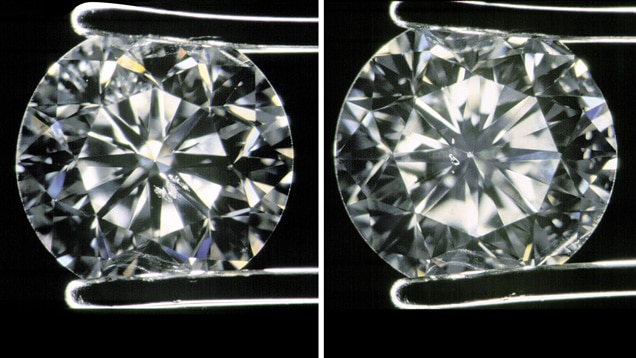
Clarity FAQs
How is a diamond’s clarity examined? In most instances, clarity is examined by jewelers and consumers using a pair of tweezers to hold the diamond and a 10X magnifying glass to view its internal inclusions.
What are the most popular clarity grades? SI1 and SI2, because inclusions of SI clarity grade diamonds are not visible to the naked eye when viewed from the top.
At what clarity grade do inclusions virtually become invisible? Using a 10X magnifying glass to examine, VS1 possibly VS2, depending on characteristics of internal inclusions.
Are two diamonds with identical clarity grade worth the same? No because one or more of the inclusions’ characteristics (size, number, position and color) are different in every diamond. For example, diamonds with black inclusions positioned closer to their center are less desirable and worth less than the ones with white inclusions located on the perimeter.
What clarity diamond should I buy? You should buy a diamond which at least looks eye clean. This means internal inclusions are not visible, or extremely difficult to locate with naked eye.
Carat Weight
Value of a diamond increases as its size (weight) increases. Weight of diamonds is measured in carats and points. One carat is = 1/5th of a gram and there are 100 points per carat. For example, a 1.05 carat diamond is one carat & five points. The larger the diamond, the higher its price per carat.
Carat Weight FAQs
What’s the difference between ‘Carat’ and ‘Karat’? ‘Carat’ is measure of weight used for gemstones and diamonds. ‘Karat’ is measure of gold purity. With 24 karat representing 100% pure gold, an 18 karat gold ring contains 75% (18/24) pure gold.
What size diamond should I buy? Best way to find out is to try on a few different sizes in the shape you are considering to purchase.
What is the best diamond size? Best diamond size is the one you like to have and wear, as it is purely based on personal taste and preference
Report/Certificate FAQs
Are all gem grading laboratories the same? No, GIA (Gemological Institute of America) is the most reliable gem grading laboratory and the industry standard.
Is it OK to buy a diamond solely based on its GIA certificate grade? Absolutely not. Buying a diamond without personal & professional examination is never a wise decision no matter how attractive its price may appear. Why? because every diamond is different and unique, regardless of its GIA grade.
How can I check authenticity of my diamond’s GIA report? Submit your diamond’s GIA certificate number online at: https://www.gia.edu/report-check-landing.
How can I get a new or replace my lost / stolen GIA report? To receive a new or replacement report, you have to submit your diamond for new grading / re-grading as GIA does not issue duplicate copies of previously graded diamonds any longer. Instructions on how to request a new report are online at: https://www.gia.edu/gem-lab-service/diamond-grading
Should I consider purchasing a diamond that is not GIA certified? You may as not all diamonds in the world are GIA certified. If you see a diamond that you really like but is not GIA certified or its report was issued by a less reliable laboratory, you may ask the seller to submit the diamond to GIA for grading. What is important is to buy a quality diamond at wholesale price and remember to never buy a diamond solely based on its grading report, even if the report was issued by GIA.
Selection & Buying
Below are the simple steps I recommend on how to select and buy the best diamond for your money based on my thirty year experience in wholesale diamond trade and fine jewelry manufacturing.
How to Select:
A: Learn the 4Cs, which explain how diamonds are graded and factors affecting their value.
B: Choose the shape of diamond you like to buy and visit jewelry store(s) in your area to see and compare a few diamonds in different sizes, colors, cuts and clarity grades.
C: Set a range for your budget.
D: Shop around: online and at reputable jewelry stores in your area to see if you can afford the size and quality you have in mind. If not possible, something has to give. Either choose a smaller size or slightly lower color or clarity. Make sure the diamond you decide to purchase meets or exceeds the following criteria
- Color is minimum ‘J’ if round and ‘H’ if it is fancy shape.
- Clarity is SI2 or better with no visible inclusions to the naked eye.
- Cut grade is Good or higher (Very Good, Excellent / Ideal).
- Fluorescence: None or faint except under limited circumstances as described above under ‘Color FAQs’ section.
Where to Buy:
A: Buy your diamond from an expert merchant who will personally examine, select and present the diamond that has the best value.
B: He/she has good knowledge of wholesale diamond prices.
C: Company has good reputation in the trade and offers only quality products.
D: Jeweler provides excellent after-sale service.
Always personally view and examine a diamond before purchase as no image, video or GIA report precisely shows all the quality characteristics of a diamond.
